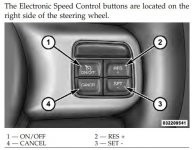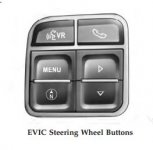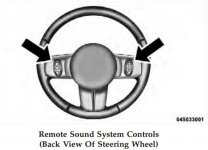You are using an out of date browser. It may not display this or other websites correctly.
You should upgrade or use an alternative browser.
You should upgrade or use an alternative browser.
Steering Wheel Control Buttons Stop Working
- Thread starter dangerruss
- Start date
GraniteCrystal
New member
Blown fuse?
rumblebee3
Caught the Bug
I know in my 04 Ram there was a clock spring recall... It's somewhere in the steering wheel assembly and I believe it is the connector for the airbag and other electronics and whenever it broke the airbag light came on along with all loss of function of my steering wheel controls. Or it could be something as simple as a blown fuse.....
Sent from my XT1585 using WAYALIFE mobile app
Sent from my XT1585 using WAYALIFE mobile app
dangerruss
New member
Speed Control Buttons all work.
View attachment 253863
None of the EVIC buttons work.
View attachment 253862
None of the remote sound system control buttons work.
View attachment 253864
Can't seem to find anything on the forum about troubleshooting the above issues. Anyone else experience the above issues? Is so, how did you fix the problem.
Thanks,
Russ
Guess I should have checked my service manual before posting... I don't have a diagnostic scan tool. Looks like it is a trip to the dealer.. Just in case some else needs the below info...
08 - Electrical / 8M - Message Center / SWITCH, EVIC Control / Operation
OPERATION
The Electronic Vehicle Information Center (EVIC) control switch pod is a resistor multiplexed unit that receives source current from and provides hard wired inputs to the Local Interface Network (LIN) slave node integral to the speed control switch pod in the right spoke of the steering wheel spoke bezel. The LIN slave node communicates the switch states of the EVIC control switch pod, the remote radio switches and the horn switch over the LIN data bus to the ElectroMechanical Instrument Cluster (EMIC) (also known as the Cab Compartment Node/CCN), which is the LIN master node.
The EVIC control switch pod (also known as the odometer switch) for vehicles not equipped with the EVIC system contains two switch push buttons whose functions are:
•Reset - This switch button allows the operator to reset the trip odometer (A or B) currently displayed in the odometer display unit of the instrument cluster.
•Step - This switch button allows the operator to step through the total odometer, trip odometer A and trip odometer B display options of the odometer display of the instrument cluster.
The EVIC control switch pod for vehicles equipped with the EVIC system contains four switch push buttons whose functions are:
•Menu - This switch button allows the operator to view the available EVIC menu items, including Compass/Temperature, Trip Computer, Navigation (if equipped), Personal Settings (also known as customer programmable features) or System Status.
•Select / Reset - This switch button allows the operator to select or reset the feature or function currently displayed in the EVIC.
•Compass - This switch button provides instant access to the compass/temperature EVIC display mode from any other mode.
•Step / Scroll Down - This switch button allows the operator to step or scroll down through options or features of the Trip Computer, Personal Settings or System Status functions.
For vehicles equipped with the Uconnect™ Hands-Free Communication System, the EVIC control switch pod contains two additional switch push buttons whose functions are:
•VR (Voice Recognition) - This switch button activates the Uconnect™ Voice Command system.
•Phone - This switch push button activates the Uconnect™ Hands-Free Phone system.
The EMIC LIN master node provides a clean ground and fused B(+) current for all of the switches and sensors on the rotating steering wheel through the LIN slave node circuitry of the speed control switch pod as well as for the Light Emitting Diode (LED) back lighting of both the speed control and the EVIC switch pods. The EMIC continually monitors the LIN bus data and will store a Signal Not Available (SNA) code for any LIN bus input errors. The EMIC also communicates with other electronic modules over the Controller Area Network (CAN) data bus. Therefore, any EMIC DTC information can be retrieved using a diagnostic scan tool connected to the Data Link Connector (DLC).
The analog resistor multiplexed circuits of the EVIC control switch pod as well as the hard wired circuits between the switch pod and the LIN slave node within the speed control switch pod may be diagnosed using conventional diagnostic tools and procedures. Refer to the appropriate wiring information. The wiring information includes wiring diagrams, proper wire and connector repair procedures, details of wire harness routing and retention, connector pin-out information and location views for the various wire harness connectors, splices and grounds.
However, conventional diagnostic methods will not prove conclusive in the diagnosis of the LIN slave or master nodes, the EMIC or the electronic controls and communication between modules and other devices that provide some features of the EVIC system. The most reliable, efficient, and accurate means to diagnose the EVIC control switch pod, the LIN slave or master nodes, the EMIC or the electronic controls and communication related to EVIC system operation requires the use of a diagnostic scan tool. Refer to the appropriate diagnostic information.
rumblebee3
Caught the Bug
Damn that sucks! Well good luck!!! Don't let them stick it in too far. [emoji50] I hate dealerships but they are getting a little better....Guess I should have checked my service manual before posting... I don't have a diagnostic scan tool. Looks like it is a trip to the dealer.. Just in case some else needs the below info...
08 - Electrical / 8M - Message Center / SWITCH, EVIC Control / Operation
OPERATION
The Electronic Vehicle Information Center (EVIC) control switch pod is a resistor multiplexed unit that receives source current from and provides hard wired inputs to the Local Interface Network (LIN) slave node integral to the speed control switch pod in the right spoke of the steering wheel spoke bezel. The LIN slave node communicates the switch states of the EVIC control switch pod, the remote radio switches and the horn switch over the LIN data bus to the ElectroMechanical Instrument Cluster (EMIC) (also known as the Cab Compartment Node/CCN), which is the LIN master node.
The EVIC control switch pod (also known as the odometer switch) for vehicles not equipped with the EVIC system contains two switch push buttons whose functions are:
•Reset - This switch button allows the operator to reset the trip odometer (A or B) currently displayed in the odometer display unit of the instrument cluster.
•Step - This switch button allows the operator to step through the total odometer, trip odometer A and trip odometer B display options of the odometer display of the instrument cluster.
The EVIC control switch pod for vehicles equipped with the EVIC system contains four switch push buttons whose functions are:
•Menu - This switch button allows the operator to view the available EVIC menu items, including Compass/Temperature, Trip Computer, Navigation (if equipped), Personal Settings (also known as customer programmable features) or System Status.
•Select / Reset - This switch button allows the operator to select or reset the feature or function currently displayed in the EVIC.
•Compass - This switch button provides instant access to the compass/temperature EVIC display mode from any other mode.
•Step / Scroll Down - This switch button allows the operator to step or scroll down through options or features of the Trip Computer, Personal Settings or System Status functions.
For vehicles equipped with the Uconnect™ Hands-Free Communication System, the EVIC control switch pod contains two additional switch push buttons whose functions are:
•VR (Voice Recognition) - This switch button activates the Uconnect™ Voice Command system.
•Phone - This switch push button activates the Uconnect™ Hands-Free Phone system.
The EMIC LIN master node provides a clean ground and fused B(+) current for all of the switches and sensors on the rotating steering wheel through the LIN slave node circuitry of the speed control switch pod as well as for the Light Emitting Diode (LED) back lighting of both the speed control and the EVIC switch pods. The EMIC continually monitors the LIN bus data and will store a Signal Not Available (SNA) code for any LIN bus input errors. The EMIC also communicates with other electronic modules over the Controller Area Network (CAN) data bus. Therefore, any EMIC DTC information can be retrieved using a diagnostic scan tool connected to the Data Link Connector (DLC).
The analog resistor multiplexed circuits of the EVIC control switch pod as well as the hard wired circuits between the switch pod and the LIN slave node within the speed control switch pod may be diagnosed using conventional diagnostic tools and procedures. Refer to the appropriate wiring information. The wiring information includes wiring diagrams, proper wire and connector repair procedures, details of wire harness routing and retention, connector pin-out information and location views for the various wire harness connectors, splices and grounds.
However, conventional diagnostic methods will not prove conclusive in the diagnosis of the LIN slave or master nodes, the EMIC or the electronic controls and communication between modules and other devices that provide some features of the EVIC system. The most reliable, efficient, and accurate means to diagnose the EVIC control switch pod, the LIN slave or master nodes, the EMIC or the electronic controls and communication related to EVIC system operation requires the use of a diagnostic scan tool. Refer to the appropriate diagnostic information.
Sent from my XT1585 using WAYALIFE mobile app
pedrosanchez1973
New member
You probably need a clockspring. It's what allows connection between those controls to the wiring at the steering column. How many miles, does your horn work, and airbag light on?
Sent from my SM-N920T using Tapatalk
Sent from my SM-N920T using Tapatalk



